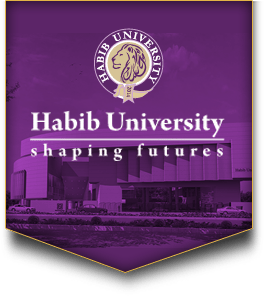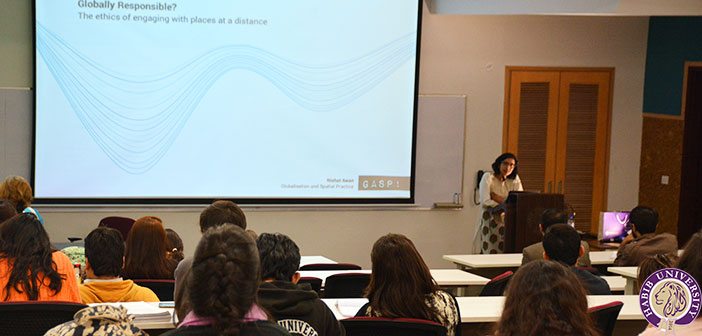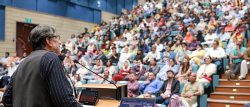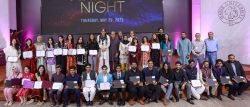YCSD Public Lecture on the global responsibility in terms of engagement
Habib University’s Yohsin Centre for Social Development (YCSD) held its first public lecture for the semester on February 17th, hosting Dr. Nishat Awan from the University of Sheffield, UK to talk about the “ethics of engaging with people at a distance”.
Under the title of “Globally Responsible?”, the talk was moderated by Dr. Hafeez Jamali, and led the discussion of the design utilized by media to portray certain areas, regions or instances, and how they can be optimally utilized in an ethical and responsible manner. Coming from a rich, diverse educational background, Dr. Awan has researched extensively on architecture and social theory, and applies an interdisciplinary approach between theory and practice.
The talk started off with a brief introduction of Dr. Awan’s previous publications, which then led to a discussion on the issues of contemporary modernity, of how our contemporary world is so deeply integrated and associated with digital images, videos and sounds.
These media require a certain kind of attention, but our engagement with them is not immediate since we are engaging with them through a technological face, usually on formats such as Facebook or Twitter.
Speaking on how we can connect to these practices in order to solicit an appropriate response, she talked on spatial practices in the wider sense.
When you look at more successful participative engagement in spaces, the work done there is long-term. However, if you’re diasporic, you don’t see that.
Observing on how the general public is so attuned to what’s happening in spaces across the world from them, through various media channels, she spoke of the importance, or lack thereof, of the distance among people. Being aware of these spaces through media does not necessarily mean we connect to them, or to situations occurring there. Spatial engagement becomes important when one is witnessing a traumatic situation second-hand, through a technological lens, comfortably distant.
She showed films and images by various journalists including Michael Buerk, whose coverage of the Ethiopian famine in 1984 shook the world. Talking about the role of social media as well, she remarked on how these images are then circulated through different avenues, changing the way we feel about certain situations because they are first-hand accounts of the reporters and the journalists, rather than fit a narrative that’s already there.
The question these media ask is that, in such times where such realities exist, whose witness accounts can you really trust? Through images or videos made by the residents of certain spaces where difficult situations are arising, you’re the witness, you make the decision of what to believe and what to take away from the film. Virtual reality is somehow used to transport you to the camp, you feel like you’re in the camp, and being there, you get to witness these traumatic events first-hand.
She also explained how easy access and multiplicity of media such as these leads to problematic themes in areas such as the aforementioned. Although there is an immediacy to them, and authenticity, the little girl being photographed in a slum in a third-world country has to bear the burden of proof, in a way she has to perform for the camera, that the situation really is as bad as this, in order for people to react appropriately.
In this case, a different set of politics and ethics is at play. There is authenticity but at the same time, the images are easily exploited and skewed to fit different themes, just because of the sheer amount of media being circulated.
To conclude her talk, she then spoke of new-age, modern techniques to focus on spatial engagement, through displaying images that gave a more of a conscious spatial perspective. This included a journalist’s technique of forcing attention on the recent drone bombing instances that the western world was not at all aware of, through the utilization of Google Earth, thus expanding on how easy it is now to be aware of one’s global surroundings.




